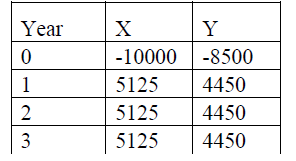Bajhang Energy Company is considering two mutually exclusive projects, X and Y. Both projects have a life of 3 years. The expected cash flows are as follows. Use MARR= 10% per year.
a) Check the feasibility of both the projects based on NPV and IRR measures.
b) Which project would you select and why?
a) Check the feasibility of both the projects based on NPV and IRR measures.
b) Which project would you select and why?



Comments
Post a Comment